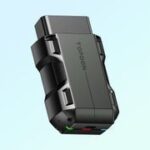Discover the power of understanding your car in real-time with an OBD scanner app. These innovative tools provide instant insights into your vehicle’s health, performance, and potential issues, right at your fingertips. If you’re wondering how to use an OBD scanner app to take control of your car maintenance, you’re in the right place. This guide will walk you through the essentials of utilizing an OBD2 scanner app to monitor your car’s condition, interpret data, and even troubleshoot problems like a professional.
OBD2 scanner apps have revolutionized car diagnostics, making it accessible and user-friendly for everyone from car enthusiasts to everyday drivers. Imagine having the ability to check why your check engine light is on, monitor engine temperature, or track fuel efficiency, all using your smartphone and a small adapter. With the right app and setup, you can unlock a wealth of information previously only available to mechanics with specialized equipment.
Getting started with an OBD scanner app is simpler than you might think. Here’s a step-by-step guide on how to use an OBD scanner app effectively:
-
Acquire an OBD2 Adapter: The first step is to obtain an OBD2 adapter. This small device plugs into your car’s OBD2 port, typically located under the dashboard on the driver’s side. These adapters communicate with your car’s computer and transmit data wirelessly to your smartphone via Bluetooth or Wi-Fi. For optimal performance, consider reputable brands like Kiwi 3, Viecar, V-Gate, Carista, LELink, or Veepeak. While cheaper Chinese adapters are available, be aware that some may be unreliable and cause connection issues. It’s generally recommended to avoid adapters marked as v.2.1 due to potential bugs.
-
Download and Install an OBD Scanner App: Next, you’ll need to choose and download an OBD scanner app on your smartphone. Car Scanner ELM OBD2 is a feature-rich option available for both iOS and Android devices. This app is designed to interface with your OBD2 adapter and translate the raw data from your car into understandable information. Install the app from your device’s app store.
-
Connect the Adapter and App: Plug the OBD2 adapter into your car’s OBD2 port. Turn your car’s ignition to the “ON” position (you don’t need to start the engine). Then, launch the Car Scanner app on your smartphone. Follow the app’s instructions to connect to your OBD2 adapter. This usually involves selecting your adapter from a list of available Bluetooth or Wi-Fi devices within the app’s settings.
-
Explore the Dashboard and Data: Once connected, the app will display a dashboard with various gauges and readings. This is where you can monitor real-time data from your car’s sensors. Car Scanner app allows you to customize your dashboard to show the parameters most important to you. You can monitor things like engine speed (RPM), coolant temperature, vehicle speed, fuel consumption, and much more.
-
Read and Clear Diagnostic Trouble Codes (DTCs): One of the most valuable features of an OBD scanner app is the ability to read Diagnostic Trouble Codes (DTCs). If your check engine light is illuminated, the app can retrieve the error code stored in your car’s computer, providing insight into the potential problem. Car Scanner app has a comprehensive database of DTC descriptions to help you understand what the codes mean. After addressing the issue, you can also use the app to clear the DTCs and turn off the check engine light.
-
Utilize Advanced Features: Car Scanner app goes beyond basic code reading. It offers advanced features such as:
- Extended PIDs: Access manufacturer-specific parameters for deeper diagnostics.
- Freeze Frames: View sensor data captured when a DTC was recorded.
- Mode 06: Access ECU self-monitoring test results for in-depth system checks.
- Emission Readiness Tests: Check if your car is ready for emissions testing.
- Performance Measurements: Measure acceleration times (0-60 mph, etc.) with accuracy.
- Trip Computer: Track fuel consumption and trip statistics.
- HUD Mode: Project dashboard data onto your windshield for convenient viewing while driving.
- Encoding Functions (VAG Cars): For Volkswagen, Audi, Skoda, and Seat vehicles on MQB and PQ26 platforms, access functions to customize hidden car settings.
By following these steps, you can effectively use an OBD scanner app like Car Scanner ELM OBD2 to gain a deeper understanding of your vehicle’s operation and health. This knowledge empowers you to perform proactive maintenance, diagnose issues early, and potentially save money on repairs. Remember that the specific sensors and data available will depend on your vehicle’s make and model. However, with an OBD scanner app, you’ll have a powerful tool for car diagnostics right in your pocket.

